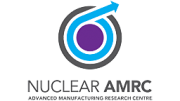The Nuclear AMRC's machining experts have made the most complex and high-value machined part for the Bloodhound supersonic car – the diffuser floor, which makes its first public appearance at the Goodwood Festival of Speed this weekend.
The diffuser floor is the largest of seven parts made by the Nuclear AMRC for Bloodhound's rear sub-frame, the assembly that holds the car's rocket engine in place and provides vital stability. Each part had to be machined from a solid block of aerospace-grade aluminium, to precise specifications, with no room for mistakes.
The diffuser floor measures about one metre square, and features a complex pattern of latticed pockets on the top side, with an aerodynamically sculpted reverse. It will sit beneath Bloodhound’s hybrid rocket engine, and provide the downward force to keep the car on the ground as it reaches 1000mph.
Creating the diffuser floor demanded a total 192 hours of machining time on the Nuclear AMRC's Hermle C60 U MT, spread over several months between industry research projects. Key stages of machining were caught on a time-lapse video camera, providing a unique view of the production process.
The finished part contains just one ninth of the metal in the original 480kg aluminium billet, with a final weight of 55kg. At its thinnest, the floor is just 5mm thick.
The machining was managed by Mathew Challinor, NC programmer at the Nuclear AMRC. Advanced machine tool operator Andrew Smedley handled work on the Hermle, and Matt Reaney completed the floor's side walls and pockets on the Starrag HEC 1800 horizontal boring centre.
"The biggest challenges were the deep pockets, which are up to 155mm deep," says Challinor. "This is very challenging for tooling, as you need a tool that has a length of 15 times its diameter. Fixturing was also a challenge, as we had to avoid vibrations in such a slender aero-like structure, while making sure the part was held securely."
With a positional accuracy of less than five microns, the Hermle's precision was vital to getting the part right first time. The Hermle also features an on-machine probe, allowing Challinor to measure features and compare to the design as cutting progressed.
"I learnt a lot about the Hermle, as this was the first job on this machine," says Challinor. "We were able to develop new processes and post-processes, all of which will benefit future projects."
On the face of it, the Bloodhound parts are very different to the large components that the Nuclear AMRC machining group usually works on for industrial partners from the energy sector.
"There's very few aluminium parts in a nuclear power station, so this isn't the kind of material we usually work with," notes Stuart Dawson, Nuclear AMRC head of machining. "But where it fits is the concept of producing very complex high-value precision parts, right first time. The principles and practices involved in nuclear manufacturing have served us very well in producing these one-off parts for Bloodhound."
Bloodhound’s Product Sponsorship Lead Conor La Grue said “The commitment of the team at Nuclear AMRC has been second to none, they have produced complex components of the highest quality and delivered to very tight schedules. We are delighted with the manufacturing partnership”.
The Nuclear AMRC was also visited by a government delegation from the Northern Cape region of South Africa in July. The visitors are responsible for preparing the Hakskeen Pan desert racetrack where the Bloodhound team will attempt to break the world Land Speed Record in 2015. The car will carry the Nuclear AMRC's logo, providing a global showcase for British manufacturing excellence.
Watch the time lapse video of the diffuser floor being machined ...


